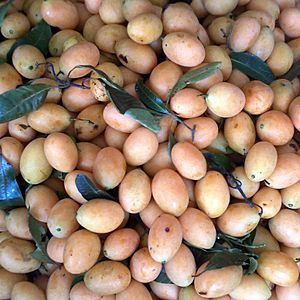Gandaria facts for kids
Quick facts for kids Gandaria |
|
|---|---|
 |
|
| Immature Bouea macrophylla in a basket | |
| Scientific classification | |
| Genus: |
Bouea
|
| Species: |
macrophylla
|
Bouea macrophylla, often called gandaria, plum mango, or mango plum, is a special flowering plant from Southeast Asia. It's a tree that belongs to the same plant family as the delicious mango and cashew nuts.
Contents
What is Gandaria?


The gandaria tree is an evergreen plant, meaning it stays green all year round. It can grow very tall, up to 25 meters (about 82 feet)! Its leaves are shaped like an oval or a spear. They can be quite long, from about 13 to 45 centimeters (5 to 17 inches), and about 5 to 7 centimeters (2 to 3 inches) wide.
The Fruit
The fruit of the gandaria tree looks a bit like a small mango. When they are young, they are green. As they ripen, they turn a bright orange or yellow color. The seed inside is usually pink. These fruits are small, typically about 2 to 5 centimeters (0.7 to 1.9 inches) across. You can eat the whole fruit, even its skin!
The taste of the fruit can be sweet or sour, much like an Alphonso mango. It also has a slight smell that reminds some people of turpentine. When the fruit is fully ripe, it becomes soft and has fibrous seeds, similar to a mango.
Flowering and Fruiting Times
The time when gandaria trees flower and produce fruit can be different depending on where they grow:
- In Thailand: The trees flower in November and December. The fruit then appears from April to May.
- In Indonesia: The trees flower from June to November. The fruit is ready to pick from March to June.
Where Does Gandaria Grow?
This tree originally comes from Indonesia and Burma. Today, you can also find it growing in Thailand, Laos, and Malaysia. In these countries, it is grown on farms for its fruit.
How is Gandaria Used?
Both the leaves and the fruit of the gandaria tree can be eaten.
Eating the Leaves and Fruit
Young gandaria leaves can be eaten raw, often added to salads. While the seed inside the fruit is technically edible, the inner part is usually bitter.
The fruit itself is quite acidic and tastes like a mango. You can eat it fresh and raw. People also use it to make different dishes like pickles, compote (a fruit sauce), or a spicy sauce called sambal. Unripe fruits are sometimes used in traditional dishes like rojak and asinan.
Other Uses for the Tree
The entire gandaria tree can be used as a beautiful shade tree. It has many leaves, which makes it great for providing shade in gardens or parks.
Other Names for Gandaria

Bouea macrophylla has many different names around the world. In English, it's known as "marian plum," "gandaria," "plum mango," and "mango plum."
In Malay, the tree is called kundang, and its fruit is buah kundang. Malays sometimes use different names for two types:
- Kundang daun kecil means "small-leaf kundang." It's also known as remia, remnia, or rumenia.
- Kundang daun besar means "large-leaf kundang." This type is sometimes called kundang hutan ("jungle kundang) or setar. The city of Alor Setar in Malaysia got its name from this tree, with alor meaning "small stream."
In Indonesian, it's known as ramania and gandaria. In Thai, you might hear it called maprang (มะปราง), mayong (มะยง), or mayong chit (มะยงชิด). In Burmese, it's mayan-thi (မရန်းသီး), and in Vietnamese, it's thanh trà.
In 2015, a big store in Britain started selling the fruit under the name plango. This name is a mix of "plum" and "mango." Some news reports mistakenly said the fruit was a cross between a plum and a mango. However, this isn't true in botany, as plums and mangoes are from completely different plant families!
See also
 In Spanish: Bouea macrophylla para niños
In Spanish: Bouea macrophylla para niños

